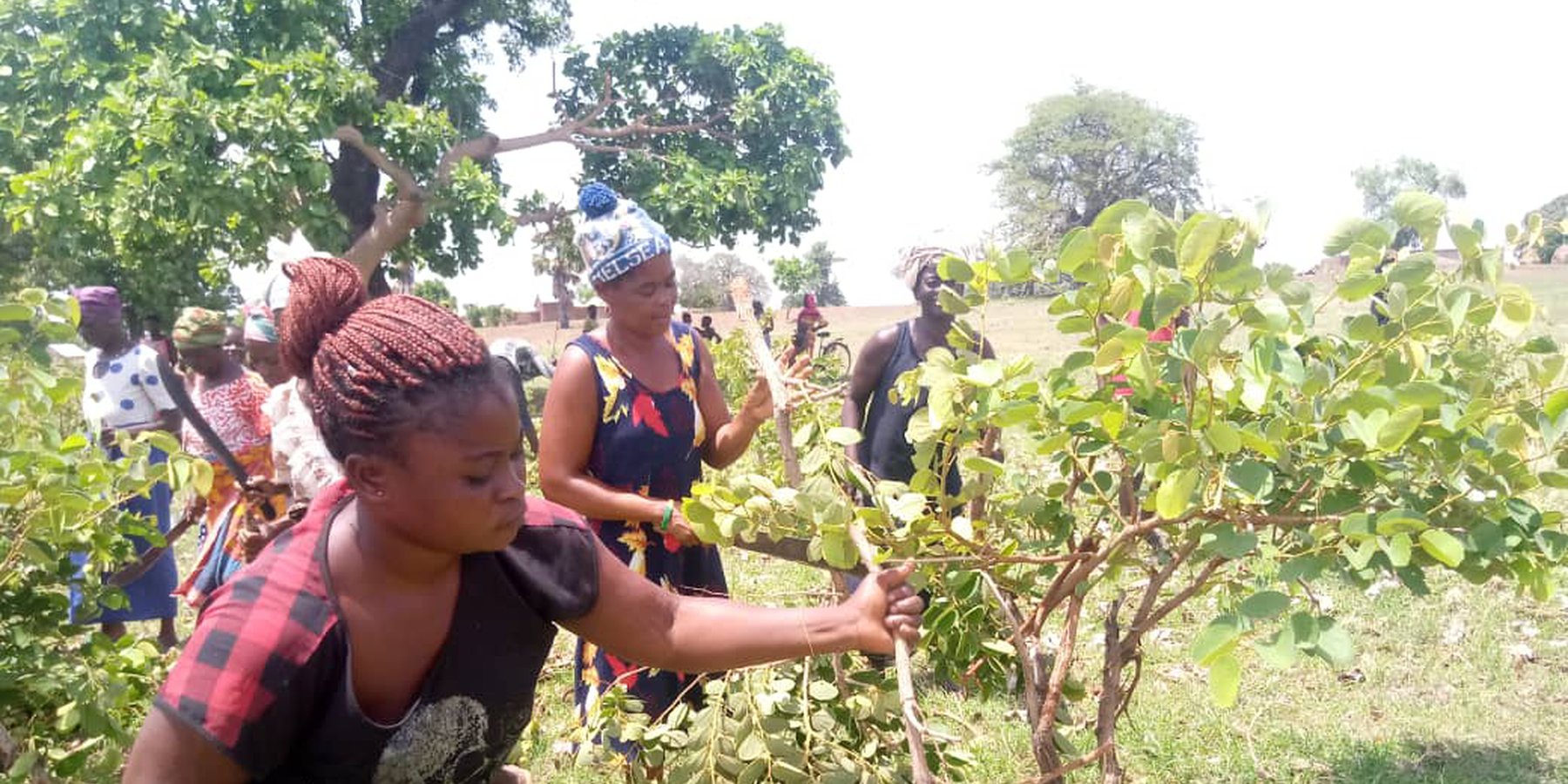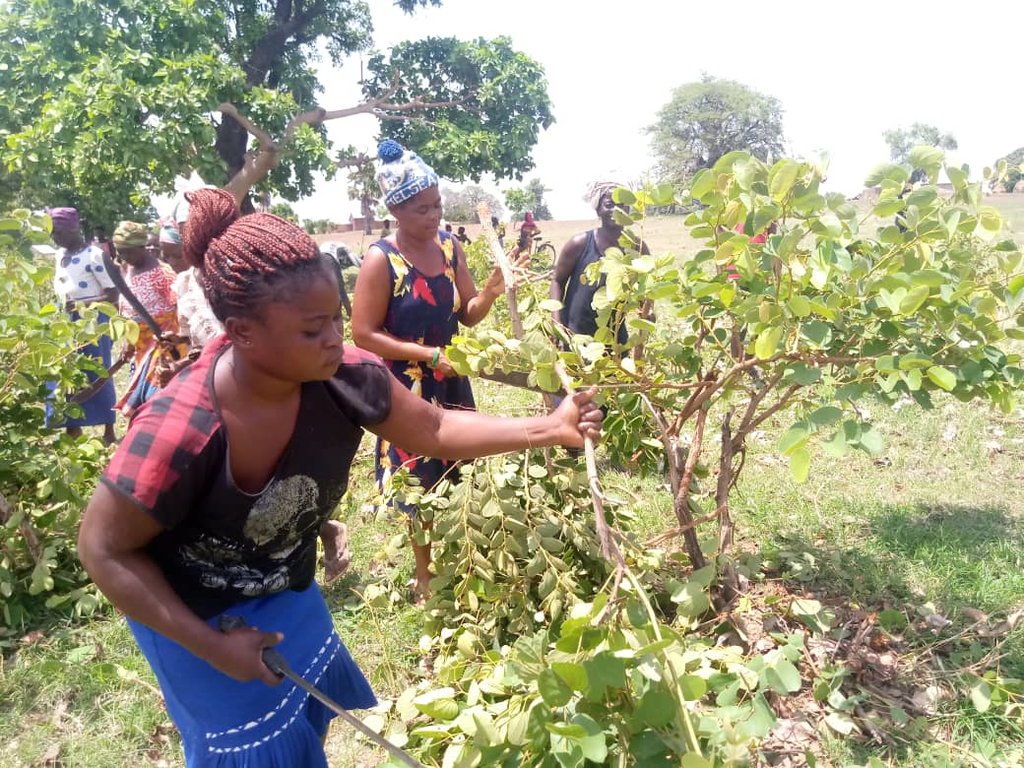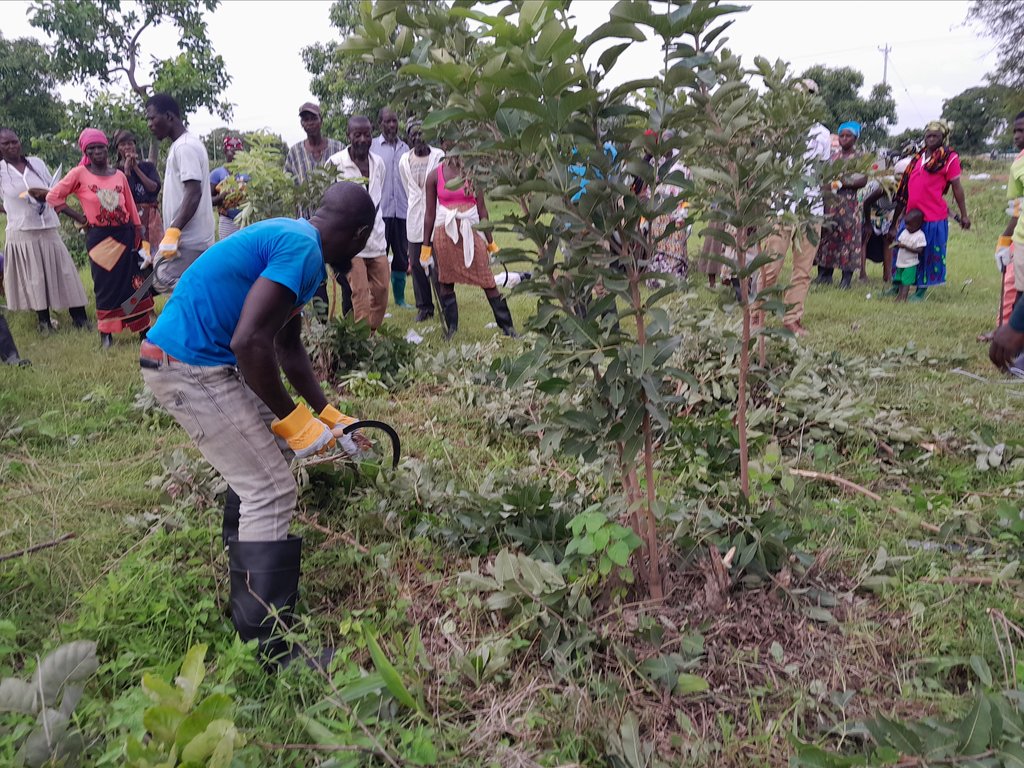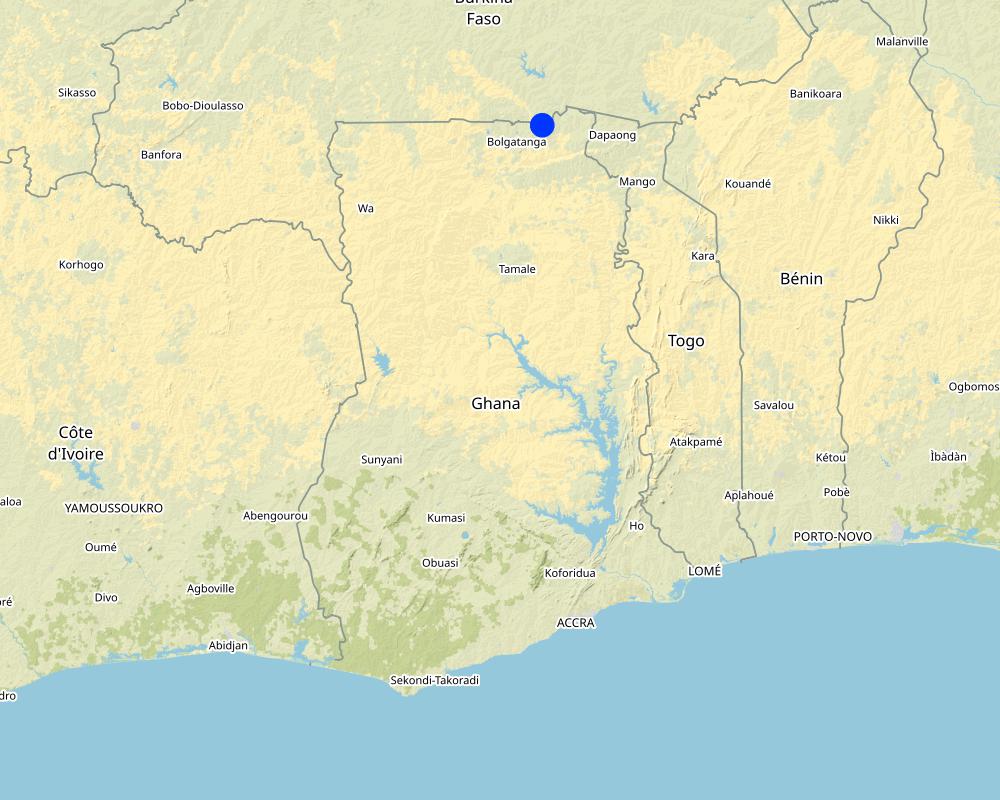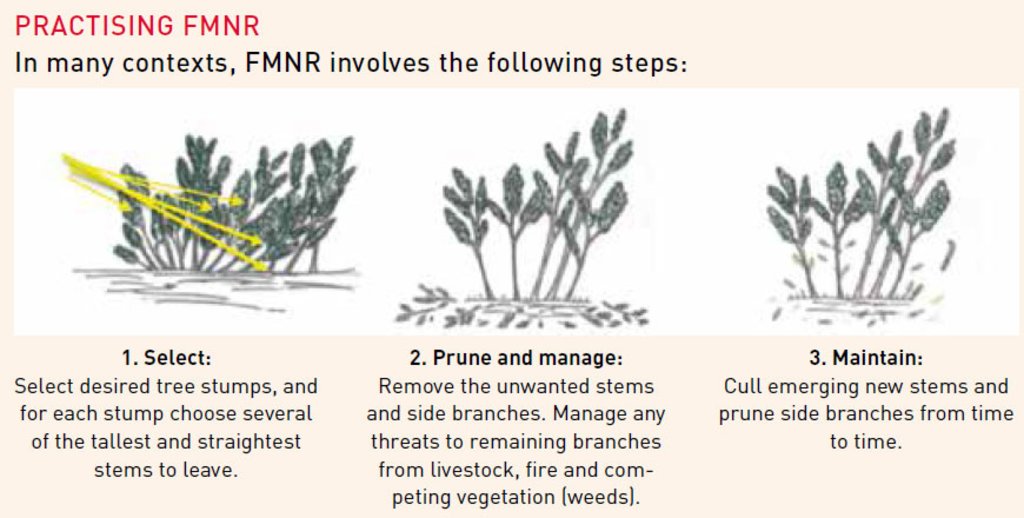Farmer Managed Natural Regeneration(FMNR) [Ghana]
- Creation:
- Update:
- Compiler: Joshua Adombire
- Editor: –
- Reviewers: William Critchley, Rima Mekdaschi Studer
Tintuug lebge tii
technologies_6599 - Ghana
View sections
Expand all Collapse all1. General information
1.2 Contact details of resource persons and institutions involved in the assessment and documentation of the Technology
Key resource person(s)
World Vision Regreening africa Project staff:
Adombire Joshua
World Vision
Ghana
Name of project which facilitated the documentation/ evaluation of the Technology (if relevant)
Reversing land degradation in Africa by scaling-up Evergreen Agriculture (Regreening Africa)Name of the institution(s) which facilitated the documentation/ evaluation of the Technology (if relevant)
Not applicable (Not applicable) - United States1.3 Conditions regarding the use of data documented through WOCAT
The compiler and key resource person(s) accept the conditions regarding the use of data documented through WOCAT:
Ja
1.4 Declaration on sustainability of the described Technology
Is the Technology described here problematic with regard to land degradation, so that it cannot be declared a sustainable land management technology?
Nee
Comments:
The technology has empirically proven to have no adverse effects on land and any other agrarian venture
1.5 Reference to Questionnaire(s) on SLM Approaches (documented using WOCAT)
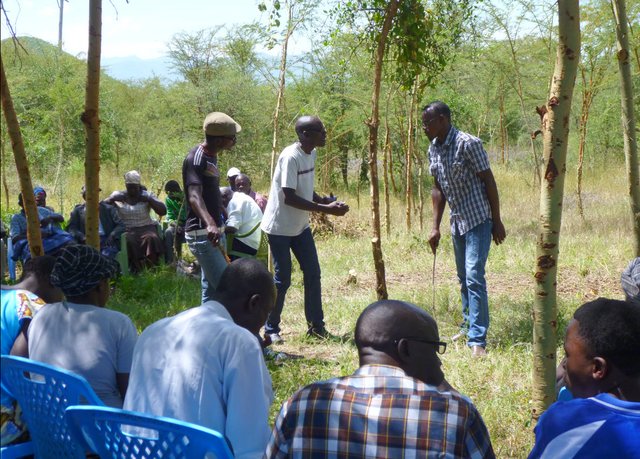
FMNR implementation approach [Kenya]
After consultations with local stakeholders, experts (from NEMA, ICRAF, KFS, Wildlife Kenya) and Homabay County Government representatives the FMNR approach is being introduced by World Vision through a public funded project. The aim of the approach is to promote FMNR and sustainable land and natural resource management through disseminating the …
- Compiler: Thomas Kalytta
2. Description of the SLM Technology
2.1 Short description of the Technology
Definition of the Technology:
Farmer Managed Natural Regeneration (FMNR) comprises a set of practices used by farmers to encourage the growth of native trees on agricultural land by systematically allowing regeneration and managing trees and shrubs from tree stumps, roots and seeds.
2.2 Detailed description of the Technology
Description:
Farmer managed natural regeneration (FMNR) is an agroforestry practice that involves the deliberate protection and management of naturally regenerating woody vegetation by farmers on agricultural land. On farmland, selected trees are trimmed and pruned to manage their growth while promoting optimal growing conditions for annual crops (such as access to water and sunlight). Naturally it is a prerequisite that there should be evidence of sprouts from stumps or roots. FMNR is practiced through - but not limited to - the following:
1. Survey of the farm noting how many and what species of trees are present; In our project impact communities, the commonest indigenous tree species are Vitellaria paradoxa, Parkia biglobosa, Adansonia digitata, Piliostigma thonningii, Combretum spp, Diospyros mespiliformis, Lanea macrocarpa, Faidherbia albida, Acacia spp etc
2. Select the stumps of the desired species for regeneration; and
3. Select the best five or so stems and cull unwanted ones.
FMNR can restore degraded farmlands, pastures and forests by increasing the quantity and quality of woody vegetation, by increasing biodiversity and by improving soil structure and fertility through leaf litter and nutrient cycling. It has been reported in Senegal and Ghana in 2011 and 2012 that households practicing FMNR were less vulnerable to extreme weather shocks such as drought and damaging rain and windstorm. Conventional approaches to reversing desertification, such as tree planting, rarely spread beyond the project boundary once external funding is withdrawn. By comparison, FMNR is cheap, rapid, locally led and implemented. It uses local skills and resources – the poorest farmers can learn by observation and teach their neighbors. This technique is popular with land users because it is a low-cost and rapid sustainable land restoration technique. A well-established FMNR is succeeded by Farmer Managed Agroforestry (FMA) where farmers are cultivating annual crops as well are conserving indigenous tree species on the arable lands. Farmers go step ahead to do enrichment planting of preferred trees species such as Mangifera indica, Anacardium occidentale, Luceaena leucocephala etc.
2.3 Photos of the Technology
General remarks regarding photos:
Farmers are always excited to learn the technique since it is easy to do irrespective of the physique of the person.
2.4 Videos of the Technology
Comments, short description:
https://1drv.ms/v/s!AszYv0MhwVNji1-Kuo6kZRifcMzj?e=CMPcE0
Date:
17/12/2022
Location:
Bawku West district
Name of videographer:
Joshua Adombire
2.5 Country/ region/ locations where the Technology has been applied and which are covered by this assessment
Country:
Ghana
Region/ State/ Province:
Upper East
Further specification of location:
Widnaba Community in Bawku West district
Specify the spread of the Technology:
- applied at specific points/ concentrated on a small area
Is/are the technology site(s) located in a permanently protected area?
Nee
Map
×2.6 Date of implementation
Indicate year of implementation:
2017
If precise year is not known, indicate approximate date:
- less than 10 years ago (recently)
2.7 Introduction of the Technology
Specify how the Technology was introduced:
- through land users' innovation
- through projects/ external interventions
Comments (type of project, etc.):
World Vision Regreening Africa Project
3. Classification of the SLM Technology
3.1 Main purpose(s) of the Technology
- improve production
- reduce, prevent, restore land degradation
- conserve ecosystem
- preserve/ improve biodiversity
- create beneficial social impact
3.2 Current land use type(s) where the Technology is applied
Land use mixed within the same land unit:
Ja
Specify mixed land use (crops/ grazing/ trees):
- Agroforestry

Cropland
- Annual cropping
- Perennial (non-woody) cropping
- Tree and shrub cropping
Annual cropping - Specify crops:
- cereals - maize
- cereals - millet
- cereals - rice (upland)
- legumes and pulses - beans
Annual cropping system:
Maize/sorghum/millet intercropped with legume
Tree and shrub cropping - Specify crops:
- cashew
Number of growing seasons per year:
- 1
Is intercropping practiced?
Ja
If yes, specify which crops are intercropped:
Cashew -legumes, cashew- cereals, Teak- cereals, Mango- cereals etc
Is crop rotation practiced?
Ja
If yes, specify:
Cereals and legumes,

Grazing land
Extensive grazing:
- Semi-nomadic pastoralism
- Free range grazing
Animal type:
- cattle - dairy and beef (e.g. zebu)
- goats
- sheep
- Donkey
Is integrated crop-livestock management practiced?
Ja
If yes, specify:
Farm residues are feed to animals and the dropping are used as manure for soil improvement. The animals are also used for farm work and other domestic works such as fetching water as in the case of donkeys
Products and services:
- manure as fertilizer/ energy production
Species:
cattle - dairy and beef (e.g. zebu)

Forest/ woodlands
- Tree plantation, afforestation
- Community forests
Tree plantation, afforestation: Specify origin and composition of species:
- Mixed varieties
Type of tree plantation, afforestation:
- tropical dry forest plantation
Type of tree:
- Acacia species
- Balanites aegyptiaca
- Tectona species
Are the trees specified above deciduous or evergreen?
- deciduous
Products and services:
- Timber
- Fuelwood
- Fruits and nuts
- Grazing/ browsing
- Protection against natural hazards
- Medicinal
Comments:
N/A
3.3 Has land use changed due to the implementation of the Technology?
Has land use changed due to the implementation of the Technology?
- No (Continue with question 3.4)
3.4 Water supply
Water supply for the land on which the Technology is applied:
- rainfed
Comments:
Some farmers dig out wells for vegetable farming in some communities
3.5 SLM group to which the Technology belongs
- natural and semi-natural forest management
- forest plantation management
- agroforestry
3.6 SLM measures comprising the Technology

agronomic measures
- A1: Vegetation/ soil cover
- A2: Organic matter/ soil fertility
- A3: Soil surface treatment
A3: Differentiate tillage systems:
A 3.2: Reduced tillage (> 30% soil cover)

vegetative measures
- V2: Grasses and perennial herbaceous plants

structural measures
- S1: Terraces
- S6: Walls, barriers, palisades, fences

management measures
- M4: Major change in timing of activities
- M5: Control/ change of species composition

other measures
Specify:
Mulching
3.7 Main types of land degradation addressed by the Technology

soil erosion by water
- Wt: loss of topsoil/ surface erosion

soil erosion by wind
- Et: loss of topsoil

chemical soil deterioration
- Cn: fertility decline and reduced organic matter content (not caused by erosion)

physical soil deterioration
- Pc: compaction

biological degradation
- Bc: reduction of vegetation cover
- Bh: loss of habitats
- Bl: loss of soil life
- Bp: increase of pests/ diseases, loss of predators

water degradation
- Ha: aridification
- Hs: change in quantity of surface water

other
Specify:
Acidification of water bodies
3.8 Prevention, reduction, or restoration of land degradation
Specify the goal of the Technology with regard to land degradation:
- prevent land degradation
- restore/ rehabilitate severely degraded land
4. Technical specifications, implementation activities, inputs, and costs
4.1 Technical drawing of the Technology
Technical specifications (related to technical drawing):
Where there are so many stands, depending on the species, some are culled leaving two to five stands of shrubs or stands. For edible fruit trees, it is recommended a single stem is left to facilitate quicker growth and fruiting.
When pruning, the cutting tool must be very sharp and cutting down upwards but not downwards to prevent tearing of the bark.
Stems must not be prune of side twigs to the apex but halfway up is recommended to give the plant more stability and opportunity for adequate photosynthesis
Author:
Van Schoubroeck, Frank (2018). Integrating trees in farming systems in Baringo County, Kenya reduced variability of food and fodder production.
Date:
17/12/2022
4.2 General information regarding the calculation of inputs and costs
Specify how costs and inputs were calculated:
- per Technology area
Indicate size and area unit:
10 acres
If using a local area unit, indicate conversion factor to one hectare (e.g. 1 ha = 2.47 acres): 1 ha =:
1 hectare= 2.5 acres
other/ national currency (specify):
Cedis
If relevant, indicate exchange rate from USD to local currency (e.g. 1 USD = 79.9 Brazilian Real): 1 USD =:
13.9493
Indicate average wage cost of hired labour per day:
N/A
4.3 Establishment activities
| Activity | Timing (season) | |
|---|---|---|
| 1. | Community entry | Any time except nights |
| 2. | Community mobilization | Any time except nights |
| 3. | Community sensitization | Any time except nights |
| 4. | Communities' selection of volunteers to be trained | Any time except nights |
| 5. | Training of volunteers on pruning and tree management | Any time except nights |
4.4 Costs and inputs needed for establishment
| Specify input | Unit | Quantity | Costs per Unit | Total costs per input | % of costs borne by land users | |
|---|---|---|---|---|---|---|
| Labour | Cutlass | piece | 40.0 | 33.0 | 1320.0 | |
| Labour | Welligtoon boot | pair | 40.0 | 50.0 | 2000.0 | |
| Labour | Communal labour | person | 40.0 | 30.0 | 1200.0 | |
| Labour | Pruning knives | piece | 40.0 | 24.0 | 960.0 | |
| Equipment | Hand gloves | pair | 40.0 | 16.0 | 640.0 | |
| Equipment | Sickles | piece | 40.0 | 28.0 | 1120.0 | |
| Equipment | N/A | |||||
| Plant material | Natural shrubs | |||||
| Fertilizers and biocides | N/A | |||||
| Construction material | N/A | |||||
| Total costs for establishment of the Technology | 7240.0 | |||||
| Total costs for establishment of the Technology in USD | 519.02 | |||||
If land user bore less than 100% of costs, indicate who covered the remaining costs:
The cost is covered by the projects
4.5 Maintenance/ recurrent activities
| Activity | Timing/ frequency | |
|---|---|---|
| 1. | Pruning of shrubs | Biweekly |
| 2. | Creation of fire belts | Every six months |
4.6 Costs and inputs needed for maintenance/ recurrent activities (per year)
| Specify input | Unit | Quantity | Costs per Unit | Total costs per input | % of costs borne by land users | |
|---|---|---|---|---|---|---|
| Labour | N/A | |||||
| Labour | Communal | person | 40.0 | 30.0 | 1200.0 | |
| Equipment | N/A | |||||
| Equipment | Cutlasses | piece | 40.0 | 33.0 | 1320.0 | |
| Equipment | Wellington boots | pair | 40.0 | 50.0 | 2000.0 | |
| Equipment | Sickles | piece | 40.0 | 28.0 | 1120.0 | |
| Equipment | Handgloves | pair | 40.0 | 16.0 | 640.0 | |
| Plant material | Pruning knives | piece | 40.0 | 24.0 | 960.0 | |
| Fertilizers and biocides | N/A | |||||
| Construction material | N/A | |||||
| Other | N/A | |||||
| Total costs for maintenance of the Technology | 7240.0 | |||||
| Total costs for maintenance of the Technology in USD | 519.02 | |||||
If land user bore less than 100% of costs, indicate who covered the remaining costs:
N/A
Comments:
It must be noted that the cost of maintenance is bored totally by the community members after the project set up the intervention. Community members in consultation with their leaders procure their own working tools and plan their work schedules while project staff conduct periodic monitoring visits to provide technical backstopping.
4.7 Most important factors affecting the costs
Describe the most determinate factors affecting the costs:
Increase in fuel prices and government tax affects cost of sickles, cutlasses, Wellington boots, pruning knives, food and snacks and T-shirts in the markets
5. Natural and human environment
5.1 Climate
Annual rainfall
- < 250 mm
- 251-500 mm
- 501-750 mm
- 751-1,000 mm
- 1,001-1,500 mm
- 1,501-2,000 mm
- 2,001-3,000 mm
- 3,001-4,000 mm
- > 4,000 mm
Specify average annual rainfall (if known), in mm:
956.00
Specifications/ comments on rainfall:
The area experience unimodal rainfall that lasts 4-6 months in a year
Indicate the name of the reference meteorological station considered:
Ghana Meteorological Agency
Agro-climatic zone
- sub-humid
5.2 Topography
Slopes on average:
- flat (0-2%)
- gentle (3-5%)
- moderate (6-10%)
- rolling (11-15%)
- hilly (16-30%)
- steep (31-60%)
- very steep (>60%)
Landforms:
- plateau/plains
- ridges
- mountain slopes
- hill slopes
- footslopes
- valley floors
Altitudinal zone:
- 0-100 m a.s.l.
- 101-500 m a.s.l.
- 501-1,000 m a.s.l.
- 1,001-1,500 m a.s.l.
- 1,501-2,000 m a.s.l.
- 2,001-2,500 m a.s.l.
- 2,501-3,000 m a.s.l.
- 3,001-4,000 m a.s.l.
- > 4,000 m a.s.l.
Indicate if the Technology is specifically applied in:
- not relevant
Comments and further specifications on topography:
The area is dominated by low lying areas with high water tables. These areas are usually used for rice cultivation and dry season gardening
5.3 Soils
Soil depth on average:
- very shallow (0-20 cm)
- shallow (21-50 cm)
- moderately deep (51-80 cm)
- deep (81-120 cm)
- very deep (> 120 cm)
Soil texture (topsoil):
- coarse/ light (sandy)
- medium (loamy, silty)
Soil texture (> 20 cm below surface):
- coarse/ light (sandy)
- medium (loamy, silty)
Topsoil organic matter:
- medium (1-3%)
5.4 Water availability and quality
Ground water table:
< 5 m
Availability of surface water:
good
Water quality (untreated):
good drinking water
Water quality refers to:
ground water
Is water salinity a problem?
Nee
Is flooding of the area occurring?
Ja
5.5 Biodiversity
Species diversity:
- medium
Habitat diversity:
- medium
5.6 Characteristics of land users applying the Technology
Sedentary or nomadic:
- Sedentary
Market orientation of production system:
- mixed (subsistence/ commercial)
Off-farm income:
- 10-50% of all income
Relative level of wealth:
- very poor
- poor
Individuals or groups:
- individual/ household
- groups/ community
Level of mechanization:
- manual work
- animal traction
Gender:
- women
- men
Age of land users:
- youth
- middle-aged
- elderly
5.7 Average area of land used by land users applying the Technology
- < 0.5 ha
- 0.5-1 ha
- 1-2 ha
- 2-5 ha
- 5-15 ha
- 15-50 ha
- 50-100 ha
- 100-500 ha
- 500-1,000 ha
- 1,000-10,000 ha
- > 10,000 ha
Is this considered small-, medium- or large-scale (referring to local context)?
- medium-scale
5.8 Land ownership, land use rights, and water use rights
Land ownership:
- communal/ village
- individual, not titled
Land use rights:
- leased
- individual
Water use rights:
- communal (organized)
- individual
Are land use rights based on a traditional legal system?
Ja
Comments:
land is either bequeathed or leased out to for use
5.9 Access to services and infrastructure
health:
- poor
- moderate
- good
education:
- poor
- moderate
- good
technical assistance:
- poor
- moderate
- good
employment (e.g. off-farm):
- poor
- moderate
- good
markets:
- poor
- moderate
- good
energy:
- poor
- moderate
- good
roads and transport:
- poor
- moderate
- good
drinking water and sanitation:
- poor
- moderate
- good
financial services:
- poor
- moderate
- good
6. Impacts and concluding statements
6.1 On-site impacts the Technology has shown
Socio-economic impacts
Production
crop production
Quantity before SLM:
200kg of grains per acre
Quantity after SLM:
200-400 kg of grain per acre
Comments/ specify:
FMNR together with appropriate land preparation and improved agronomic practices promoted by the project have resulted in increased soil productivity
crop quality
Quantity before SLM:
N/A
Quantity after SLM:
N/A
Comments/ specify:
Interventions such as post-harvest loss management trainings facilitated by the project have resulted in increased quality of farm produce.
fodder production
Quantity before SLM:
Scarce
Quantity after SLM:
Available
Comments/ specify:
Through enrichment planting of browse tree species such as Leucaena, Albizia, there's availability of fodder for animals
fodder quality
Quantity before SLM:
Scarce
Quantity after SLM:
Available
Comments/ specify:
There are Faidherbia, Lecaena, Albizia as protein and vitamin source for ruminants in the communities
animal production
Quantity before SLM:
Few (about 1 ruminants)
Quantity after SLM:
2-3 ruminants per household
Comments/ specify:
The project supported vulnerable house households with at least two she- goats each to keep for their well -being
wood production
Quantity before SLM:
N/A
Quantity after SLM:
N/A
Comments/ specify:
Prunings serve as readily available firewood. Some bigger branches are also pruned for use. Introduction of fast-growing tree species such as Tectona grandis enables farmer easily harvest wood
forest/ woodland quality
Quantity before SLM:
Maximum 1
Quantity after SLM:
At least 2
non-wood forest production
Quantity before SLM:
N/A
Quantity after SLM:
N/A
risk of production failure
Comments/ specify:
FMNR on farms create micro-climate which helps in preventing total crop failure.
product diversity
production area
Quantity before SLM:
0.5 acre
Quantity after SLM:
1 acre
Comments/ specify:
The project supports vulnerable families with improved maize and cowpea seeds in the cropping seasons to farm at least an acre of land
land management
Quantity before SLM:
N/A
Quantity after SLM:
N/A
Comments/ specify:
Through trainings on appropriate land preparations, good agronomic practices etc there has been improvement in land management techniques.
energy generation
Quantity before SLM:
N/A
Quantity after SLM:
N/A
Comments/ specify:
With the introduction of energy efficient cooking stoves, less fuel wood is used to generate more long-lasting heat for cooking and other domestic uses
Water availability and quality
drinking water availability
Quantity before SLM:
N/A
Quantity after SLM:
N/A
Comments/ specify:
Water bodies experience less siltation and also last longer before drying up than before the technology
drinking water quality
Quantity before SLM:
N/A
Quantity after SLM:
N/A
water availability for livestock
Quantity before SLM:
N/A
Quantity after SLM:
N/A
Comments/ specify:
There's availability of clean surface water for livestock for especially loner duration of the dry season
water quality for livestock
Quantity before SLM:
N/A
Quantity after SLM:
N/A
Comments/ specify:
Surface water bodies are less contaminated by debris from the environment dure to sequestration by trees
irrigation water availability
Quantity before SLM:
N/A
Quantity after SLM:
N/A
Comments/ specify:
There's availability of more surface water bodies for irrigation purposes
irrigation water quality
demand for irrigation water
Quantity before SLM:
N/A
Quantity after SLM:
N/A
Comments/ specify:
There's less surface water contamination
Income and costs
expenses on agricultural inputs
Quantity before SLM:
N/A
Quantity after SLM:
N/A
Comments/ specify:
Little or no expenditure on soil fertility improvement fertilizers
farm income
Quantity before SLM:
N/A
Quantity after SLM:
N/A
Comments/ specify:
Less inputs with resultant increased yields result in increased farmers income
diversity of income sources
Quantity before SLM:
1
Quantity after SLM:
2
Comments/ specify:
Farmers can now rear livestock in addition to crops for diverse income sources
economic disparities
workload
Quantity before SLM:
N/A
Quantity after SLM:
N/A
Comments/ specify:
There's some form of release on workload as less time and distance is made in collecting fuelwood.
Socio-cultural impacts
food security/ self-sufficiency
Comments/ specify:
Increased in productivity for the peasant farmers ensures food security and some sort of self-sufficiency as some of the produce could be sold to meet other family needs.
health situation
Quantity before SLM:
N/A
Quantity after SLM:
N/A
Comments/ specify:
Food availability, access and utilization leads to improved nutrition and ultimately improvement in health conditions for the farmers.
land use/ water rights
cultural opportunities
recreational opportunities
community institutions
Comments/ specify:
The technology facilitates community to put in place structures towards environmental governance
national institutions
Comments/ specify:
The technology is gradually creeping into the government environmental protection and farming policies.
conflict mitigation
Quantity before SLM:
N/A
Quantity after SLM:
N/A
Comments/ specify:
Formation of community committees to spearhead land restoration approaches have reduce conflicts in communities.
situation of socially and economically disadvantaged groups
Comments/ specify:
The disadvantage in the communities have been supported with seeds and livestock for their welfare
Ecological impacts
Water cycle/ runoff
water quantity
Comments/ specify:
There's minimal runoff due to increase in tree population on the environment
water quality
Comments/ specify:
There's less of acid rains due to carbon sequestration by trees in the atmosphere
harvesting/ collection of water
surface runoff
excess water drainage
evaporation
Soil
soil moisture
Comments/ specify:
Increased in soil organic Carbon (SOC) build up and leaf litter serves as mulch and retains soil moisture for longer period.
soil cover
Comments/ specify:
Increased in tree density, SOC protects soil from adversaries
soil loss
Quantity before SLM:
N/A
Quantity after SLM:
N/A
Comments/ specify:
There less soil loss as soil erosion and other harmful environmental agents are checked
soil accumulation
Quantity before SLM:
N/A
Quantity after SLM:
N/A
Comments/ specify:
SOC builds up the topsoil layer of the soil
soil crusting/ sealing
Quantity before SLM:
N/A
Quantity after SLM:
N/A
Comments/ specify:
There's less soil sealing as a result of appropriate land preparation and good agronomic practices the technology promotes .
soil compaction
Comments/ specify:
There's less soil sealing as a result of appropriate land preparation the technology promotes.
nutrient cycling/ recharge
Comments/ specify:
Improved
salinity
Comments/ specify:
The technology promotes less use of NPK fertilizers thereby reducing soil salinity
soil organic matter/ below ground C
Quantity before SLM:
N/A
Quantity after SLM:
N/A
Comments/ specify:
Leaf litter increases soil organic matter content in the soil
acidity
Quantity before SLM:
N/A
Quantity after SLM:
N/A
Comments/ specify:
There is sequestration of acid forming gases by trees thereby reducing acidity
Biodiversity: vegetation, animals
Vegetation cover
biomass/ above ground C
plant diversity
invasive alien species
Comments/ specify:
There's reduction in invasive alien species as they are culled in FMNR technology
animal diversity
beneficial species
habitat diversity
pest/ disease control
Climate and disaster risk reduction
flood impacts
landslides/ debris flows
drought impacts
impacts of cyclones, rain storms
emission of carbon and greenhouse gases
fire risk
wind velocity
micro-climate
6.2 Off-site impacts the Technology has shown
water availability
reliable and stable stream flows in dry season
downstream flooding
downstream siltation
groundwater/ river pollution
buffering/ filtering capacity
wind transported sediments
damage on neighbours' fields
damage on public/ private infrastructure
impact of greenhouse gases
6.3 Exposure and sensitivity of the Technology to gradual climate change and climate-related extremes/ disasters (as perceived by land users)
Gradual climate change
Gradual climate change
| Season | increase or decrease | How does the Technology cope with it? | |
|---|---|---|---|
| annual temperature | increase | moderately | |
| seasonal temperature | dry season | increase | moderately |
| annual rainfall | increase | very well | |
| seasonal rainfall | wet/ rainy season | increase | moderately |
Climate-related extremes (disasters)
Meteorological disasters
| How does the Technology cope with it? | |
|---|---|
| tropical storm | moderately |
| extra-tropical cyclone | not known |
| local rainstorm | very well |
| local thunderstorm | very well |
| local hailstorm | not known |
| local snowstorm | not known |
| local sandstorm/ duststorm | not known |
| local windstorm | very well |
| tornado | not known |
Climatological disasters
| How does the Technology cope with it? | |
|---|---|
| heatwave | very well |
| cold wave | very well |
| extreme winter conditions | not known |
| drought | moderately |
| forest fire | moderately |
| land fire | moderately |
Hydrological disasters
| How does the Technology cope with it? | |
|---|---|
| general (river) flood | moderately |
| flash flood | moderately |
| storm surge/ coastal flood | not known |
| landslide | not known |
| avalanche | not known |
Biological disasters
| How does the Technology cope with it? | |
|---|---|
| epidemic diseases | moderately |
| insect/ worm infestation | moderately |
6.4 Cost-benefit analysis
How do the benefits compare with the establishment costs (from land users’ perspective)?
Short-term returns:
slightly positive
Long-term returns:
very positive
How do the benefits compare with the maintenance/ recurrent costs (from land users' perspective)?
Short-term returns:
slightly positive
Long-term returns:
very positive
6.5 Adoption of the Technology
- > 50%
If available, quantify (no. of households and/ or area covered):
0ver 100 households
Of all those who have adopted the Technology, how many did so spontaneously, i.e. without receiving any material incentives/ payments?
- 51-90%
Comments:
These spontaneous adopters used their own locally tools in practices the technology on their own arable lands due to the anticipated benefits of the technology
6.6 Adaptation
Has the Technology been modified recently to adapt to changing conditions?
Nee
6.7 Strengths/ advantages/ opportunities of the Technology
| Strengths/ advantages/ opportunities in the land user’s view |
|---|
| It is easy to adopt and adapt |
| It has no negative effects on agriculture |
| It is the appropriate approach to resorting biodiversity in communities |
| Strengths/ advantages/ opportunities in the compiler’s or other key resource person’s view |
|---|
| The technology is low cost, very effective and every community is endowed with the natural resources to practice it |
6.8 Weaknesses/ disadvantages/ risks of the Technology and ways of overcoming them
| Weaknesses/ disadvantages/ risks in the land user’s view | How can they be overcome? |
|---|---|
| It requires entire community by-in for a start-up | Communities are better sensitized and educated on the technology |
| Difficulty in getting tools and materials for pruning | Projects support with cutlasses, knives, sickles, safety gears to work |
| Indiscriminate cutting and wildfires retard the regeneration of trees | Community fire stewards and extensive sensitizations on wildfires and bye- laws on environmental management are being enforced |
| Weaknesses/ disadvantages/ risks in the compiler’s or other key resource person’s view | How can they be overcome? |
|---|---|
| Practitioners at times depend so much on projects to support them sustain the technology on communal lands | More training on sustainability after projects |
| Burning of farmlands deprives arable lands of shrubs and saplings to practice the technology | Intensification of trainings on appropriate land preparation technologies. |
| Invasive species such as Leucaena, teak etc taking over community forests | Culling out of invasive species in community forests |
7. References and links
7.1 Methods/ sources of information
- field visits, field surveys
400
- interviews with land users
20
- interviews with SLM specialists/ experts
15
- compilation from reports and other existing documentation
10
7.2 References to available publications
Title, author, year, ISBN:
4.Diagne, M., 2012, "Evaluation Finale du Projet Beysatol", World Vision Senegal.The social, environmental and economic benefits of Farmer Managed Natural Regeneration: R Francis, P Weston, J Birch - World Vision Australia, 2015 - worldvision.org, Assessing social equity in farmer-managed natural regeneration (FMNR) interventions: findings from ghana M Kandel, G Agaba, RS Alare, T Addoah… - Ecological …, 2021 - er.uwpress.org
Available from where? Costs?
Google Scholar
7.3 Links to relevant online information
Title/ description:
Farmer-managed natural regeneration. (2022, November 4).
URL:
https://en.wikipedia.org/wiki/Farmer-managed_natural_regeneration
7.4 General comments
The Questionnaire needs to be treated as a research work with the relevant experts to populate the data
Links and modules
Expand all Collapse allLinks

FMNR implementation approach [Kenya]
After consultations with local stakeholders, experts (from NEMA, ICRAF, KFS, Wildlife Kenya) and Homabay County Government representatives the FMNR approach is being introduced by World Vision through a public funded project. The aim of the approach is to promote FMNR and sustainable land and natural resource management through disseminating the …
- Compiler: Thomas Kalytta
Modules
No modules


